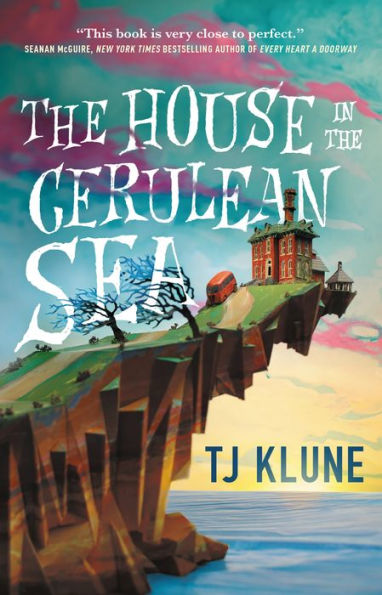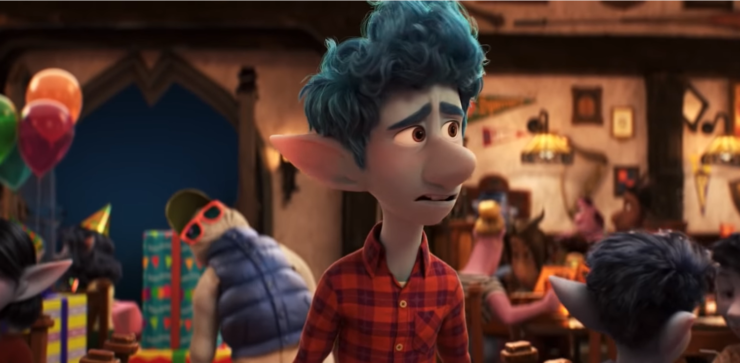Alfred Hitchcock liked to cite the following, hypothetical scene to explain his approach to storytelling: Two characters sit at a table, having a conversation. The chat goes on for about five minutes, when suddenly, FWOOM!, a bomb explodes. The audience is startled, shocked; it’s an adrenaline moment. Okay. Fine.
Now rewind. Same scene as before, only this time, it starts with a glimpse under the table. We see the bomb, see its timer is set for five minutes. The conversation proceeds, but now we’re on the edge of our seats, knowing something the characters don’t and thus fully invested in their fates.
In short, with the right set up, you can turn a fleeting moment of sensation into a full journey. And although Hitchcock used the example to explain how to create suspense, the technique is not restricted to that one form of audience investment. Not surprisingly, the concept applies quite well to films where an actual journey is involved.
In the new Disney/Pixar film Onward, two elf brothers go on a magical quest to resurrect their dead father. Well, actually, younger brother Ian (voiced by Tom Holland), who never really got to know his father before the man passed, has already managed to conjure half of his Pops—the lower half, a pair of legs that stumble around endearingly—before the mystical crystal used to perform the magic fractures. It now falls to Ian and older brother Barley (Chris Pratt) to seek out a replacement crystal before the twenty-four hour spell dissipates, and Ian’s opportunity to do all the father-son things he’s missed out on (the teen has a list) is lost forever.
It should be noted at this point that this tale is set in a world where magic has largely been supplanted by our own, modern conveniences, so smartphones replace telepathy, the tavern previously patronized by scum and villains is now a family-friendly theme restaurant, and Ian and Barley’s epic journey is undertaken not upon noble steeds but within the elder brother’s grotty, unicorn-bedecked van.
Buy the Book


The House in the Cerulean Sea
To director Dan Scanlon’s credit, he manages to find a lot of fun in the set-up. A biker club is populated by a swarm of pissed-off, bad-mannered sprites; Mom’s (Julia Louis-Dreyfus) new boyfriend (Mel Rodriguez) is both a police officer and a centaur, which leads to a bit of awkwardness when he has to get into or out of his patrol vehicle; and the Chuck E. Cheese-ish tavern is managed by Mandy the Manticore (Octavia Spencer), who with a bit of goading reverts to her mythical ferocity and manages some PG-rated carnage by decapitating the rubber head of a walkaround character.
All this is cool, and there’s lots of it. Yet something is missing. It may be a flaw in the fundamental mise en scene of the film—by robbing this fantasy world of its fantasy setting, the anachronisms don’t land with same impact as they would in, say, Miracle Workers: Dark Ages, or even Jay Ward’s Fractured Fairy Tales. There should be an anarchic snap to watching a bunch of leather-bedecked sprites infest a gas-station convenience store; here, in a conventional suburban setting where fantasy and reality cross in every frame, where dragons are kept as pets and unicorns have become the equivalent of trash-scavenging racoons, it just recedes into the scenery. Even when the brothers’ travels take them off the beaten path (in other words, off the freeway) and into a world of towering, twisted foliage and mammoth statuary, neither characters nor film stop to marvel at the grandeur.
That pallidness extends to the relationship between Ian and Barley. The plot is based in the shy, straight-laced, plaid-shirt-wearing Ian’s desperation to finally meet his father, yet, aside from him heading to school in his father’s old sports jersey and his obsessing over a brief snippet of his dad’s voice on an audio cassette, we never get the sense of how deeply that desire resonates on an emotional level, or any real understanding of the personalities involved. (Just conjecture on my part, but I got hints that a possible opening sequence better defining who the father was had been replaced with a lighter prologue filling in the history of this world; maybe because, for whatever reason, Pixar didn’t want to go the full Up route this time around).
Meanwhile, the effusive, jean-vest sporting Barley is even more sketchily defined. He lives at home, but doesn’t go to the same school as Ian (or at least Ian’s classmates—including a demon who ambulates on crutches, in a nice bit of inclusion—don’t recognize him); he’s an inveterate fantasy gamer—his campaign is spread across the kitchen table (in fitting with the world, its big selling point is that it’s historically accurate)—but he apparently doesn’t have anyone to play with. Barley has no friends, no job—he’s the Manic Elfin Dream Boy, a character who exists only in context to how he defines Ian.
The problem here is that the relationship between the two siblings is clearly supposed to be a fractious one, but director Scanlon has decided to rely too much on Chris Pratt’s Chris Pratt-ness, and so instead of an irritant, Barley becomes just another Pratteseque lovable doof. Ian’s reactions as a result are tempered; there’s never any real friction to the siblings’ exchanges. Part of this may be that Scanlon has based his story on the relationship he had with his actual brother, and both boys’ desire to better know a father who died while they were still very young. The modulation may make the rapport more accurate, but this may have been the place where it would have been wiser to go with the tale’s hyperbolic fantasy side than its grounded, suburban setting. Without that drama, we’re left wondering why this trip matters at all.
[WARNING: SPOILER SECTION—skip over the next two paragraphs if you’d like to avoid spoilers…]
This lack of definition in the characters’ relationships is felt in how the emotional impact of the film’s finale lands. Towards the end, Ian goes through a written list of things he wanted to do with his father—charmingly mundane stuff like having a driving lesson—and realizes that it’s all the things he’s done with Barley during their quest. Suddenly it comes clear, at least in the story context, why Ian’s desire to meet his father has never felt deeply motivated: the connection he seeks is not with a father he’s never known, but with the brother who’s been his staunchest, if irritating, ally, and most vociferous, if embarrassing, advocate. In accepting the value of his sibling, Ian comes also to accept that Barley is more deserving of a meeting, however brief, with the father that he knew far better.
But, you see, here’s where the Hitchcock aspect informs: A closing moment where Ian watches from afar as Barley and Dad interact is sweetly moving (yeah, I teared up, what of it?). But that moment could have resonated much more if Ian’s tenuous desire to know his father was better delineated, if Barley’s relationship with the man was more clearly defined, and if the siblings’ interactions had more focus. If you know your Pixar, you’ll recognize Ian’s epiphany as parallel to the one in Pete Docter’s Inside Out, in which Joy realizes she is pointless without Sadness. In Inside Out, though, the two characters were more clearly and keenly defined, and Joy’s desperation to keep her teenage host happy and her frustration at Sadness’ interference is deeply felt, having been woven into the fabric of the story, not simply telegraphed at the start. With that clarity, plus the emotional milestones added in the course of their odyssey (poor Bing Bong!), the characters’ final destination—their realization of what they mean to each other—has serious emotional weight. Onward gets us to appreciate the stakes at the end and feel for the characters, but an inability to accurately map out the route to this revelation makes it just a nice moment, rather than a richly justified, rewarding destination.
[END SPOILER SECTION]
Onward is fun enough, and sweet enough. It lands somewhere in the group with Monsters University (also directed by Scanlon) and The Good Dinosaur, enjoyable adventures that echo Pixar’s more visionary efforts without bringing anything of their own to the table. It still stands heads and (dragons’) tails above the rest of the increasingly desultory CG animated field (and points have to be given to Scanlon and crew for staging the story in a fantasy world without succumbing to the hacky pop culture gags a less-inspired studio would have lunged for). Onward’s emotional journey may not be as epic as its creators intended, but as an entertaining side-trip, it casts a pleasant spell.
* * *
But you know what’s the real magic? Diversity of opinion! Yes, we are all magicians of our own hearts, wielding the enchanted wands of our thoughts born from the mystical rivers of our experiences, doing noble battle with the foul orcs and detestable dragons of… uh… bad, crabby guys who cast… um, silence incantations… Okay, I’ve lost the thread. My point is that there’s a comments section below, and I want to hear your thoughts on Onward, on whether you think its cross-breeding of fantasy and technology is successful, if the destination is worth the trip, and if there are better examples to consume, or worse ones to avoid (and yeah, I can see you Bright-haters straining at the gate…). Have at it!
Dan Persons has been knocking about the genre media beat for, oh, a good handful of years, now. He’s presently house critic for the radio show Hour of the Wolf on WBAI 99.5FM in New York, and previously was editor of Cinefantastique and Animefantastique, as well as producer of news updates for The Monster Channel. He is also founder of Anime Philadelphia, a program to encourage theatrical screenings of Japanese animation. And you should taste his One Alarm Chili! Wow!











My thoughts are essentially the same as yours. The plot beats were pretty formulaic, just dressed up differently. The younger set enjoyed it, but it didn’t click for most of the adults. There are some adult-oriented moments that kids won’t get (so either enjoy the surface aspect or don’t get it at all), and references to other movies such as when crossing the chasm. TTRPG players get some gags, but it rapidly grows old. I saw a couple of plot holes big enough for Mandy to fly through.
I enjoyed it. The desire to spend one more day with their father will probably hit a lot of people right in the heart. I’m kind of opposite of you, though: I thought Ian’s desire to see his father was effectively conveyed with the cassette tape portion but the (highlight for spoilers)/revelation that his relationship with his brother was what he really wanted came out of left field to me. That wasn’t something I felt that the movie adequately set up./
I may feel differently after seeing it, but I appreciate this as a concept. To us – the viewers – this is new and interesting, but to the characters this is their world. I feel snapped out of disbelief whenever a character stops to marvel at what should be to them a commonplace occurrence. I suppose that presenting them to the audience with wonder while not disturbing the characters may be the mark of a good fantasy author/director.
Also, as a complete aside, why haven’t we had a Ryan Reynolds / Chris Pratt buddy movie yet? Let Ryan Ryan and let Chris Chris and see what happens, Peter’s Friends style!